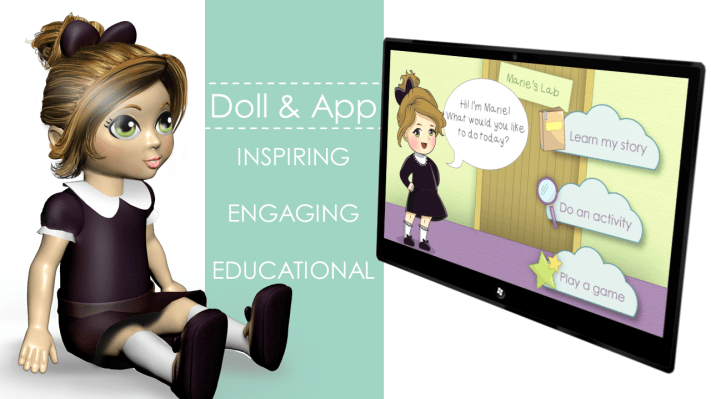Looking around their engineering classes at the University of Illinois, Supriya Hobbs and Janna Eaves noticed something was missing — other girls.
And so like good engineers, they set out to solve that problem. The recent graduate and college senior invented Miss Possible, a doll and accompanying app aiming to spark an interest in math and science among young girls.
The Miss Possible dolls are based on real women who have been trailblazers in the fields of math and science. The first Miss Possible will be Marie Curie, the famed chemist and physicist who remains the only person to win the Nobel Prize in multiple science fields. In the app that will accompany the Miss Possible doll, girls can learn about the famous woman’s story, do hands-on activities with materials found around the house or play in-app games.
Miss Possible: Dolls to Inspire Girls Across Generations from Supriya Hobbs on Vimeo.
Hobbs and Eaves have created an American Girl doll for the 21st century. Like me, Hobbs said she played with American Girl dolls growing up. Those dolls brought a message of female empowerment to ‘90s kids using American history and arts and crafts. Miss Possible does it with science and an app.
As company after company releases diversity reports that show women are underrepresented in tech positions, that might just be the kind of doll girls need.
This isn’t the first time we’ve seen attempts to attract girls to STEM fields with dolls. Mattel made headlines just a few months ago with its rollout of Entrepreneur Barbie.
Entrepreneur is an important addition to Barbie’s list of careers. Running a startup was the next logical career move for a woman who’s traveled to space, gotten her medical degree and modeled in fashion shows.
But Miss Possible is special because she’s not a plastic blonde with unrealistic body proportions and pointy feet. She’s based on a real woman with a real life who young girls can look up to. After Marie Curie, Hobbs and Eaves have plans to make dolls based on the first African-American female aviator, Bessie Coleman, and the first programmer, Ada Lovelace.
“There’s research showing role models matter,” Hobbs said. “Early exposure to these fields makes a difference.”
Hobbs’ mother, who has a background in science, has been her lifelong role model. From the time Hobbs was a young girl, she has only considered jobs in the math and science field — first planning to become a doctor and then shifting to engineering as she got older. But she realizes this isn’t the case for all girls.
“I think studying engineering is a deliberate for women, but for some male students in college, it’s a default decision,” Hobbs says.
Hobbs believes at least in her experience at University of Illinois, support networks were in place for female engineers once they chose to take those classes. The problem starts before college.
Hobbs and Eaves were inspired to create the dolls after volunteering to help with science courses in schools while at college. They launched an Indiegogo campaign in July to fund the project. Hobbs said the campaign’s goal of $75,000 is the absolute minimum amount the girls need to launch the project. Hobbs and Eaves hope to surpass that goal and encourage supporters who like the idea but don’t want to purchase a doll to still contribute, and they will donate the doll to a charitable organization.
In the past, efforts to get young girls interested in coding or math and science fields using dolls or shopping games have been criticized.
“People say why do we have to do anything special to get girls interested in these fields, but […] clearly what we’ve been doing hasn’t panned out,” Hobbs said with the confidence you’d expect from the founder of a doll called Ms. Possible. “I say try everything we can.”
